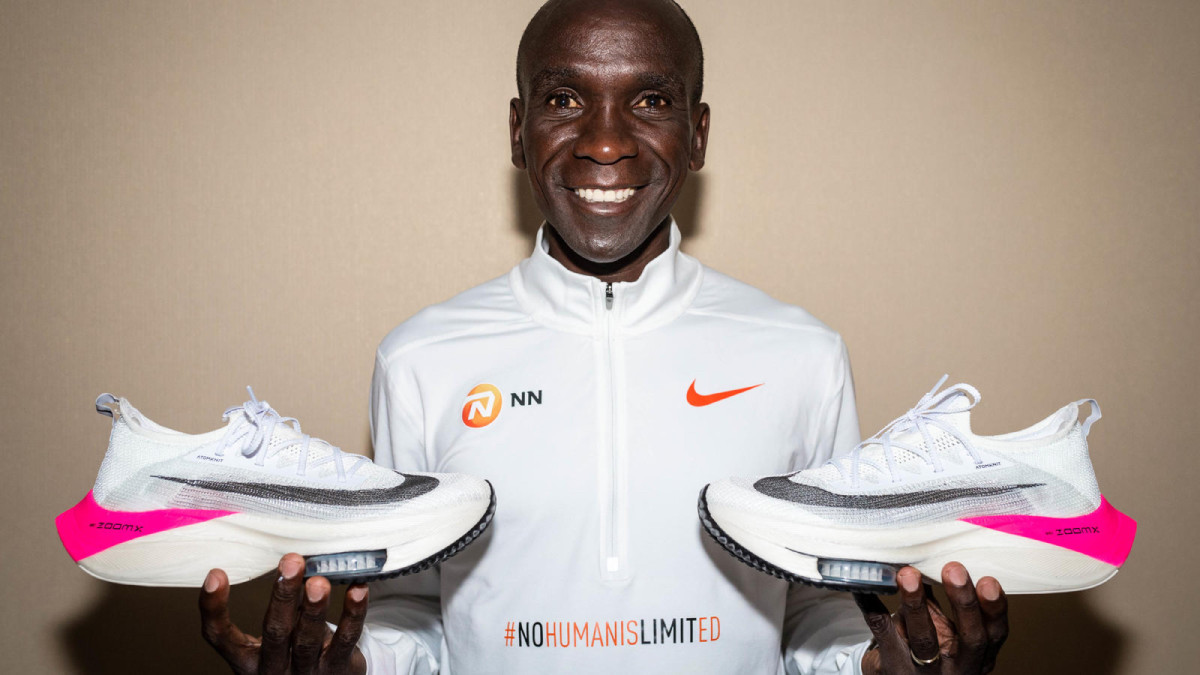Nike VaporFly Shoes Avoid Ban as World Athletics Imposes New Limits on Shoe Technology

On Friday, World Athletics, the global governing body of track and field, released new regulations on footwear, banning any shoe with a maximum sole thickness of more than 40mm and shoes that contain more than one plate.
Under the new regulations, the current version of Nike's VaporFly Next% shoes—which have been popularized by elite and amateur runners, but have stirred debate regarding their threat to the integrity of the sport—will not be banned. The Nike VaporFly Next% shoes have a stack height of 40mm, which would meet the limit.
The future of shoe technology will likely be impacted by the governing body's new ruling, which improved upon its previous, vague stance, which read: “Shoes must not be constructed so as to give athletes any unfair assistance or advantage.” A technical committee was established in November 2019 to examine controversial footwear in hopes of a resolution to the growing uproar and concern before this summer’s Olympics. Nike has repeatedly said its shoes meet the IAAF requirements and do not violate any rules.
Under the new rules, any shoe must be “reasonably available to all in the spirit of the universality of athletics.” Any shoe that is introduced to the open retail market after April 30, 2020, may not be used in races unless it has been available for purchase by anyone for at least four months prior to competition. If a shoe does not meet these criteria, it is considered a prototype.
The new rules also state that shoes must not contain more than one carbon fiber blade, plate or “any other material with similar properties or producing similar effects, whether that plate runs the full length of the shoe or only part of the length of the shoe.”
In the release, there is an additional note from World Athletics:
“At least four months prior to an International Competition at which an athlete proposes to wear a shoe that has not previously been used in International Competitions, the athlete (or their representative) must submit to World Athletics the specification (i.e. size, dimensions, sole thickness, structure etc.) of that new shoe; confirm if the new shoe is to be customized in any way; and provide information about the availability of the new shoe on the open retail market. After reviewing this information World Athletics may request that samples of the shoe be submitted by the manufacturer for further examination. If the shoe is requested for further investigation, World Athletics will use reasonable efforts to complete its examination as soon as practicable (if possible, within 30 days of receipt of the shoe by World Athletics).”
World Athletics also stated that if it believes a shoe or specific technology does not comply with the letter or spirit of the rules, it can call for that shoe or technology to be prohibited in competition until fully examined.
Nike’s VaporFly shoes, which are easily recognizable in races due to bright-green and pink colorways, have been at the center of controversy dating back to 2016, when several sponsored athletes competed in prototypes at the U.S. Olympic marathon trials and then at the Olympics in Rio de Janeiro. Critics say the shoes, which feature a carbon fiber plate and cushioning foam in the midsole, provide an unfair advantage due to the energy return that has led to faster times than competitor shoes. The shoes have resulted in an arms race among other companies such as Saucony, Asics, Brooks, New Balance and HOKA One One to create a competitor that can keep up, with target dates as soon as the U.S. Olympic marathon trials on Feb. 29 in Atlanta. Saucony, Brooks and HOKA also now have shoes that feature a carbon fiber plate.
Those companies may now have to rush their products out to be eligible for use at the Summer Games in Tokyo.
In July 2018, The New York Times released the findings of its own study using data from fitness app Strava that determined runners in the Vaporflys clocked times that were 3% to 4% faster than similar runners in other shoes. It also found that the Vaporflys were more than 1% faster than the next-best racing shoe. The Times analyzed results from about 280,000 marathon and 215,000 half marathon performances. Last December, the Times revisited the latest shoe technology to include the Next% and found that runners were 4% to 5% faster than the next-best shoe.
Nike officially unveiled its VaporFly technology in 2017, when the sportswear company sponsored an optimized exhibition race for Kenyan marathoner Eliud Kipchoge to break two hours in the marathon. Kipchoge fell just 25 seconds shy of making history but in addition to the perfect course, fueling and weather conditions, the shoes made a marginal difference. He wore the 4% shoes when he broke the marathon world record in two hours, one minute and 39 seconds at the 2018 Berlin Marathon. Three years later, the sportswear company upgraded the shoes for Kipchoge to wear at the 2019 London Marathon with its VaporFly Next% shoes, which have more foam than the 4% and are composed of lighter upper material. He ran the then-second-fastest marathon time in history with them and won the race in 2:02:37. The five-fastest marathons in history have been run by men in VaporFly Next% shoes.
Fellow Kenyan Brigid Kosgei amplified the VaporFly debate when she broke Paula Radcliffe’s marathon world record of 2:15:25, which had stood since 2003, by 81 seconds. Her 2:14:04 world record at the Chicago Marathon came just one day after Kipchoge became the first man to break the two-hour marathon barrier and gave the world a sneak peek at the next installation of the VaporFly tech.
During the INEOS 1:59 Challenge, another optimized sub-two attempt, Kipchoge wore the AlphaFlys. Nike released photos of the shoe, but very few details. A patent was uncovered by a running blog that suggested the new shoe has four cushioning pods on the sole, two layers of midsole foam and three carbon fiber plate layers.

The shoe has been seen in some domestic U.S. races as a prototype on wear-testers and also on some U.S. contenders for the marathon trials like Bernard Lagat—who will be going for his fifth Olympic team at 45. Under the new regulations, the Nike AlphaFlys will not be allowed at the U.S. Olympic Trials, since they are still not on sale to the general public and, thus, do not meet the availability guidelines set by World Athletics.
The new rules could also impact new track spikes that Nike is working to possibly unveil this spring or summer. Much like the AlphaFlys, prototypes that have been seen online appear to use air bladders for a spring-effect.
The new regulations set by World Athletics are a step forward in limiting the manufacturer arms race that’s distracting from the athletic footrace, but shoes are more complex than putting a blanket limit on the construction. Now that there are defined limits, it seems that the next step for footwear innovation will be working within World Athletics’ constraints to optimize shoes for individual runners.
Quick Takeaways
Here are a few takeaways with the help of the University of Michigan’s biomechanist Geoff Burns, who proposal to regulate footwear in road running in the British Journal of Sports Medicine and was recently featured in a video on the VaporFly debate by the Wall Street Journal.
Does World Athletics Need to Do More Than Just A Max Height?
“I think this was a great start and 90% of the way there. If I was writing the specific regulation, I would have some linear length-to-height relation. Otherwise, a really short person could theoretically extract a greater benefit from a 40-millimeter shoe than a tall person because it’s a greater percentage of increase in their leg length. That’s one thing I hope they would tweak: make a more explicit relation there instead of just capping at a solid line.
The other thing to keep in mind is how you measure a shoe and how much you can compress it. Foams, sock liners and shoe components are compressible. If you’re measuring the thickness, how much are you pressing down on it? These are things an engineer would be thinking about and how you attach explicit instructions to reduce measurement variability”
How enforceable is the rule on multiple blades?“Any shoe with spikes used in competition must not contain any rigid plate or blade made from carbon fiber or another material with similar properties or producing similar effects.”
“Those aren’t really enforceable words. We can’t act on "similar properties or producing similar effects". You can make plates or elements that are similar to carbon fiber, but who determines what "similar properties" or "effects" are? There is no mechanical property specified, and magnitude or degree of similarity defined. Moreover, the aspect of testing or enforcing that seems like it could create more headaches than necessary. Carbon fiber is radiolucent, so you can't x-ray it. So now we have to either cut-up shoes or get an MRI or CT on them? Are races going to drop thousands of dollars to do those on suspect shoes? No way. It all seems reactionary and discriminatory toward the VaporFly, and may not be necessary with the height restriction.”
What impact do you think this will have on the rumored Nike track spikes?
“This seems like it will still allow the air bladder under the forefoot, though it's not clear if the additional plate to "used solely attach spikes to the outer underside of the shoe" indicates whether it can or can't be used to sandwich that bladder. What I think is most interesting about the air bladders in those spikes is that you can theoretically pressurize it to different effective stiffnesses. So, you could create shoes with customized pressures for different individuals and events. At different speeds, you have different contact times and rates of force generation. A sprinter might want something highly pressurized for a fast, stiff response, whereas a distance runner with a slightly longer contact might benefit from a slightly lower pressure. Having a bladder that can be tuned to the mechanics and contact frequencies of runners for different events could be really interesting. It's not clear to me how these rules would affect that technology. Again, it's interesting, but I'm not sure if that's a box we want to open. Moreover, we don't even have any data or concrete descriptions of them on which to judge. The maximum thickness of 30 millimeters (for track spikes) is a lot of wiggle room and those spikes might fall under that limit.”
How does this compare to all the parallels drawn to other sports and their technological reckonings?
"Most other sports have to deal with this. Sports like cycling and swimming realized very quickly that as soon as technological changes and equipment selections from the athletes could be bigger performance discriminants that the athletes themselves, it started to become unappealing both for the fans. Moreoever, it started souring those within the competitive architecture of the sports at all levels - youth to masters. They realized it wasn’t sustainable for the sport. Cycling has had to do it on many aspects and components of the bikes. Swimming had to deal with the tech suits in 2008 and 2009 that they ultimately restricted.
We concluded our proposal in the BMJ saying, “A standard for a maximal shoe midsole thickness provides a simple, robust, enforceable rule for footwear in athletics. It would protect past, present, and future performances under a single operational definition of “fair” competitive footwear. It would prevent running competition from devolving into an “arms race” of additive, larger, and more complex shoes and retain the essence of the competition for what it is—a foot race.”
On the whole, I think this is a positive move for the long term health and spirit of the sport."
